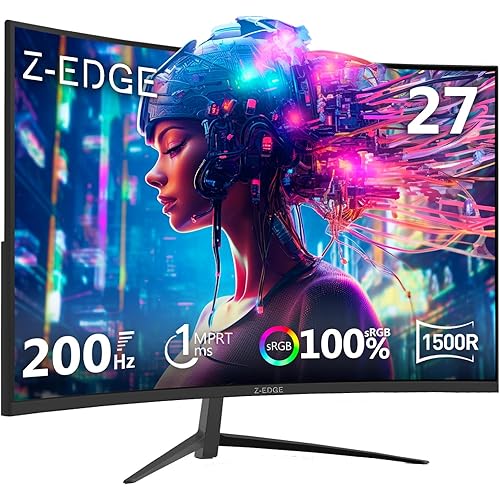ASUS ROG Swift 27”1440P OLED DSC Gaming Monitor (PG27AQDM) - QHD (2560x1440), 240Hz, 0.03ms, G-SYNC Compatible, Anti-Glare Micro-Texture Coating, 99% DCI-P3, True 10-bit, DisplayPort,Black









Buy Now, Pay Later
- – Up to 36-month term if approved
- – No impact on credit
- – Instant approval decision
- – Secure and straightforward checkout
Ready to go? Add this product to your cart and select a plan during checkout.
Payment plans are offered through our trusted finance partners Klarna, Affirm, Afterpay, Apple Pay, and PayTomorrow. No-credit-needed leasing options through Acima may also be available at checkout.
Learn more about financing & leasing here.
Selected Option
FREE refund/replacement until Jan 31, 2026 Learn more
To qualify for a full refund, items must be returned in their original, unused condition. If an item is returned in a used, damaged, or materially different state, you may be granted a partial refund.
To initiate a return, please visit our Returns Center.
View our full returns policy here.
Recently Viewed
Style: 27" OLED QHD 0.03ms 240Hz G-SYNC True 10-bit
Features
- 26.5-inch QHD (2560 x 1440) OLED gaming monitor with 240 Hz refresh rate for immersive gaming
- Highly efficient custom heatsink, plus intelligent voltage optimization for better heat management to reduce the risk of burn-in
- Anti-glare micro-texture coating reduces reflections for accurate colors and better viewing experiences
- Ultrafast 0.03 ms response time, plus the darkest black hues, high perceptual 1000 nits peak brightness (3% of the screen with HDR on), 99% DCI-P3 gamut, and Delta E < 2 color difference for astonishing HDR performance
- G-Sync compatible technology delivers seamless, tear-free gaming; and optional uniform brightness setting ensures consistent luminance levels
- DisplayWidget Center enables easy OLED and monitor settings adjustments with a mouse
- Whats in the box: USB 3.0 cable, DisplayPort cable, HDMI cable, Power cord & adapter, ROG pouch, ROG sticker, VESA mount kit, Color pre-calibration report, Quick start guide, Warranty Card
- 3-month Adobe Creative Cloud: Receive complimentary access with the purchase of this product (valid until 8/31/2026)
Description
The 27” 1440P ASUS ROG Swift PG27AQDM OLED gaming monitor features true 10-bit and delivers 240Hz refresh rate and 0.03ms fast response time. With unique custom heatsink for better cooling and performance and intelligent voltage optimization to maximize the lifespan of the OLED panel.
Brand: ASUS
Screen Size: 27 Inches
Resolution: QHD Wide 1440p
Aspect Ratio: 169
Screen Surface Description: Matte
Standing screen display size: 27 Inches
Screen Resolution: 2560x1440
Max Screen Resolution: 2560 x 1440 Pixels
Number of USB 2.0 Ports: 2
Number of USB 3.0 Ports: 2
Brand: ASUS
Series: PG27AQDM
Item model number: PG27AQDM
Item Weight: 15.21 pounds
Product Dimensions: 23.82 x 10.79 x 17.24 inches
Item Dimensions LxWxH: 23.82 x 10.79 x 17.24 inches
Color: BLACK
Manufacturer: ASUS
Date First Available: April 14, 2023
Frequently asked questions
Similar Products
Top Amazon Reviews
🚀 Abunda's Overview
This is our summary and key points to consider based on customer reviews.
The product receives glowing reviews for its high-quality display and gaming performance. One reviewer praises the 24" FHD 144Hz monitor for its sleek design, excellent stand, bright and colorful display, and impressive refresh rate, making it a fantastic choice for gamers and serious PC users. Another reviewer shares a positive experience with the 49" Curved QHD ultrawide, highlighting its perfect panel with no defects, natural colors, and convenient USB-C connectivity, which supports an extensive workstation setup including video and power over a single cable. Both emphasize the monitors' value, particularly for gaming, professional use, and multitasking, backed by a reassuring warranty period.
Pros
- 🖥️ High-quality, defect-free displays across models
- 🎮 Dedicated features for gamers, like high refresh rates
- 🔌 Convenient connectivity options, especially USB-C for workstation setups
- 👓 Comfortable viewing experience thanks to thoughtful design and ergonomics
- 💡 Bright and vibrant colors enhancing user experience
- 💸 Great value for the price, especially when on sale
Cons
- 🎨 Color settings may require adjustment out of the box for optimal performance
- 🔊 Built-in speakers are not high quality
- 🖥️ Some models may have less ideal pixel density for very close-up work
Should I Buy It?
Yes, if you're in the market for a monitor that excels in gaming performance, display quality, and ergonomic design, these ASUS monitors are highly recommended. They offer great value for their price, particularly for gamers and professionals looking for a reliable, high-performing display. However, those highly sensitive to color accuracy out of the box or in need of superior built-in speakers might want to explore additional options.























